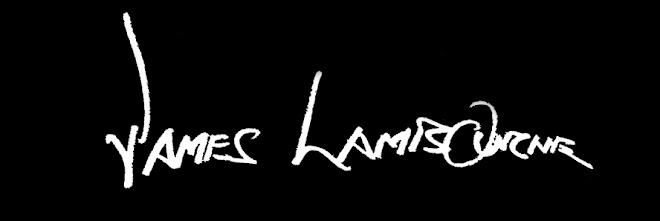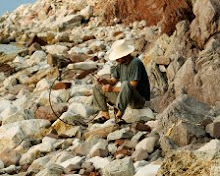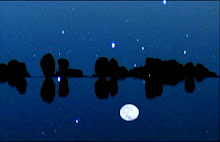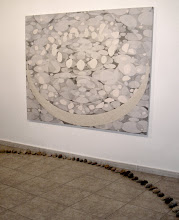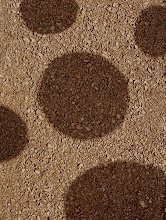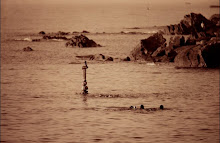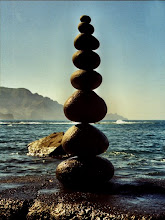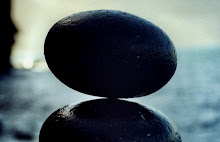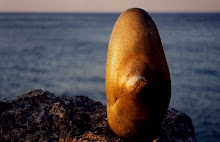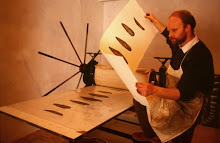Fragmento del documental 'Cicles, James Lambourne' where the artist introduces us to his work with the stone circles.
STONE CIRCLES
Fragmento del documental 'Cicles, James Lambourne' where the artist introduces us to his work with the stone circles.
EXHIBITION 'CICLES'. FUNDACIÓ PILAR I JOAN MIRÓ A MALLORCA
JAMES LAMBOURNE: MEMORY OF A LANDSCAPE
“We feel accountable for the deterioration of the world,
but we don't feel responsible for its beauty”.
Stefano Zecchi
Practically since he was a child, without realising that there was a whole generation of artists who were doing the same thing but in a highly conscious way, James Lambourne has carried out a series of spontaneous exercises in nature that fit perfectly within the conceptual confines of Land Art. Resulting from his interest in nature, his ephemeral actions on the craggy coast of Valldemossa and other places on Mallorca gradually amassed objects on the shelves of his studies that had been collected over the years without any artistic intent. His walks observing and collecting the most diverse natural or artificial materials, whose capricious shapes, textures or colours had caught the artist's eye, also gradually became the most constant stimulus for his exploration of the plastic arts.
An attentive examination of Lambourne's work categorically reveals the close interconnection between these elements hoarded over the years, between his learning about the processes of the transformation of light and of organic materials and his artistic work which, in reality, cannot be understood without the arguments provided to the artist by nature itself. The spirit of detail, intimacy and poetry of his paintings and drawings is also directly related to his profound symbiosis with the landscape of these locations where, even today, there is a spiritual encounter between land and sea. The sudden glint of light on the rocks, the unusual textures and colours left by the plants after their contact with the stone and the artist's fascination with the processes of maturing and transforming of flowers and fruits, have greatly modulated the gaze of James Lambourne, sketch artist and painter. We may state, without fear of error, that Mallorca's land and sea, its fields and river courses, have been not only a privileged place where the artist has found freedom for his inspiration, but also the most valuable source of formal and unwritten symbolic knowledge.
His ephemeral work on the natural environment, changing the position and combining differently the elements that he would come across. His pastime of setting up mounds or fitas by balancing stones of different proportions on top of each other. Composing sculptures-collages out of stones, wood, iron, branches, corks, glass, etc. His compositions with ceramic tiles and other vestiges of industry. His gardens of sand, stones and dry seaweed (Poseidon sea grass). All these creative activities, which have only recently been recorded on camera, not only form an indissoluble part of the spirit of James Lambourne's work but also allow us to establish its equivalences and similarities with those of such outstanding artists in the area of nature art as Richard Long, Andy Goldsworthy, Michael Heizer, James Pierce or Robert Smithson, to name just a few of those closest to his work.
But the work of James Lambourne also connects, and very closely, with the ethical view and analytical and research methodology of Joan Miró. Like him, Lambourne has developed a poetry that aims to synchronise the singular and the universal, or the random and the philosophically complex. His unitary concept of the internal order of nature also corresponds with the respectful view of creation running through all Miró's work. Like Miró, James Lambourne manipulates natural elements which he recognises as "works of art" per se: he collets stones that become "sculptures", discerns anthropomorphic figures in fallen trunks, draws secret constellations on maps of coloured sand and pebbles, and dreams of reunifying this fracture engendered by the alternations of time.
The series of pieces using materials from his study conceived by James Lambourne for the exterior areas of the Pilar i Joan Miró a Mallorca Foundation reveals all these connections and, at the same time, sustains the singularity of his work.
As can be seen in the most frequent shapes used by the artist (such as the circle, sphere, ellipsis or vertical projection of stone), his observing of nature is closely related to James Lambourne's desire to get close to the enigmas that are concerned with the order of the real. Hence, for example, his interest in the series of shapes and marks left on fields in the south of England and other places in the world that are only visible at a certain distance from the ground (like the famous crop circles), or those primitive stone shapes erected by prehistoric man that point to the sun and the stars, so much in evidence on the Balearic Islands.
Aware of the possibility to regain the symbolic value of these shapes known since time immemorial, James Lambourne tries to provide them with a new contemporary meaning. This is the case of the stone mounds and circles that he reinterprets in his fitas and other elliptical compositions,[1] which, curiously, are reminiscent both of the systems used to mark out boundaries as well as of particular events in recent memory, such as the spontaneous accumulation of stones created by followers of Nelson Mandela on attending the classes at his improvised “University” in a cave in South Africa.[2]
As he is Mallorcan by adoption, the Ramon Llull connection and the work of this illustrious philosopher could not escape Lambourne's reflection and artistic re-creation, who is also a conscientious reader of mythology[3] and religious history, as well as a great music lover[4]. Symbolically, and to connect the thought and memory of Ramon Llull with the artistic space of the Foundation, the stones from one of the fitas deposited by the artist in his gardens come from the sacred mountain of Randa[5].
Readers of this brief introduction will no doubt be aware that Lambourne's gaze, as with Miró, is always projected in two complementary directions: from the land to the sky and from the logic of nature to the metaphysical of the spirit. That is why, and to conclude, I would like to emphasise the fact that James Lambourne's vision is convinced of the harmony between the microcosmic and the macrocosmic,[6] an aspect that is encapsulated wonderfully in the extremely beautiful rock of enormous proportions whose component parts have been recomposed by the artist, and in the exceptional compilation of broken stones that form part of the itinerary of Lambourne's work in the outdoor areas and gardens of the Pilar i Joan Miró a Mallorca Foundation.
Amassed throughout years of patient and tenacious observation and search, these stones' fragments were often spread out in areas very distant from each other. Proof of this are the different textures and colours exhibited by these fragments that we can now see reintegrated into a whole. Reddened by their contact with the earth or iron, green from moss, bleached by the sun or their edges smoothed by the sea, they are the most beautiful metaphor of that infinite beauty for which we are not accountable but without which we would surely not be able to live.
Pilar Ribal
May 2006
[1] The eclipse, as is well known, introduces the macrocosm, the universe, into this microcosm generated by the geometric form per se.
[2] Something that James Lambourne was unaware of until he visited South Africa, where he erected mounds in the same place where Nelson Mandela had given his classes.
[3] “The Golden Bough” by Sir James Frazer is one of his favourite books.
[4] James Lambourne is the author of an extraordinary series of drawings, “Les fites de la música” (The mounds of music), which are based on a combination, in the manner of a musical score, of his iconographic repertoire with signs similar to musical notes. The composer and pianist Iván Martín also wrote a score based on these drawings.
[5] Where the philosopher's inspiration originated.
[6] Music, and specifically the theory of musical spheres, as well as the scientific principles of the universe's creation and development, are also important references in his work.
